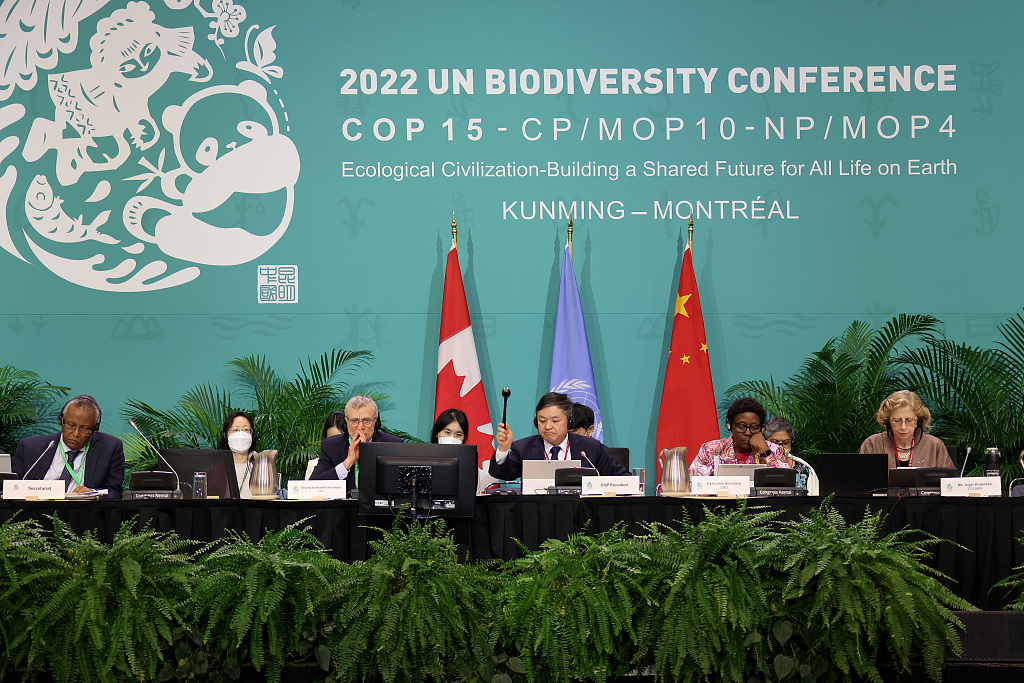
The final round of the plenary sessions of the 15th meeting of the Conference of the Parties to the UN Convention on Biological Diversity is held in Montreal, Canada, December 19, 2022. /CFP
The final round of the plenary sessions of the 15th meeting of the Conference of the Parties to the UN Convention on Biological Diversity is held in Montreal, Canada, December 19, 2022. /CFP
Editor's note: Stephen Ndegwa is the Executive Director of South-South Dialogues, a Nairobi-based communications development think tank. The article reflects the author's opinions and not necessarily those of CGTN.
On December 19 the curtains were drawn on the 15th meeting of the Conference of the Parties (COP15) to the United Nations Convention on Biological Diversity (CBD) held in Montreal, Canada, since December 7. After four years of negotiations, countries have agreed on the much-anticipated Kunming-Montreal Global Biodiversity Framework (GBF), seen by environmentalists as the saving grace for the ecology.
Many warnings have been given that degradation of ecosystems and the drastic decline of biodiversity is exacerbating climate change and threatening the natural processes, which protect human health and provide clean air, water and food. The increasing risk of extinction of species that sustain life does not augur well for life on earth.
Biodiversity indicators around the world have been declining even amid myriad policy formulations. The policies have not been followed through, which means that environmental destruction has moved in tandem with ills like pollution and overexploitation of natural resources.
The main focus turns on implementation of the GBF, which would curb and mitigate the loss of biodiversity in the world by 2030. The GBF offers a roadmap at the national and global levels.
The new deal for the environment has been enhanced from the 20 Aichi Biodiversity Targets. It is based on scientific and measurable outcomes embedded with a monitoring and evaluation mechanism. Such a framework is crucial in achieving both the visions of the UN Sustainable Goals by 2030 and living in harmony with nature by 2050.
The GBF comprises 23 targets for the protection and restoration of biodiversity. The new strategy includes a target for the conservation and management of at least 30 percent of the world's land and water by 2030. Stakeholders agreed on key issues, including goals and targets, resource mobilization and digital sequence information.
While new targets have been set, the icing on the cake is the commitment by all countries to conserve and manage 30 percent of the world's land and water. Other targets include the inclusion of distinct components for each of the three levels of biodiversity – ecosystems, species, and genetic diversity. Parties have also agreed on some of the more contentious issues, particularly on finance.

Kunming-Montreal Global Biodiversity Framework was adopted at the COP15, Montreal, Canada, December 19, 2022. /CFP
Kunming-Montreal Global Biodiversity Framework was adopted at the COP15, Montreal, Canada, December 19, 2022. /CFP
As the country with the COP15 presidency, China endorsed and inspired the process that culminated in the ratification of the GBF. The GBF drafters benchmarked with the country's lessons learnt and successes in protecting the environment in the last three decades under the China Council for International Cooperation on Environment and Development.
China's growing international leadership, credibility and influence in many sectors has helped the country to mobilize critical and transformative action where needed. It is a boon for the GBF as effective environmental action needs all hands on deck, from governments and civil society, to the private sector and communities.
The UN Environment Program (UNEP) endorses China's leadership in the GBF initiative and notes that the country's work will serve as a staging platform for meeting any commitments under the agreement. The UNEP cites that nature reserves account for about 18 percent of China's land area, which is aimed at pursuing holistic conservation and management of mountain, river, forest, farmland, lake, grassland, and desert ecosystems.
The global environmental body says what China has already done will serve as a staging platform for meeting any commitments under the global biodiversity framework.
The COVID-19 pandemic made matters worse for the environment by diverting funds that were otherwise allocated for conservation programs. Consequently, it is estimated that the current budget for supporting the GBF must be increased for it to have the expected impact. Governments alone cannot manage to meet this budget, which means that more sources of funds need to be identified.
The GBF puts the onus of raising implementation funds for the benefit of developing countries, least developed countries, small island developing states and countries with economies in transition on developed countries. It is estimated the task will require at least $20 billion per year by 2025, and at least $30 billion per year by 2030.
Meanwhile, the GBF has received the support of the financial sector, with more than 150 financial institutions pledging $24 trillion in global assets to reverse biodiversity loss.
Healthy ecosystems support 55 percent of global Gross Domestic Product (GDP). Sustainable development, which the GBF seeks will be made possible through conservation of the world's biodiversity. The weakening of the planks under the GBF can only lead to higher costs of production and scarcity of raw materials or other natural resource inputs.
(If you want to contribute and have specific expertise, please contact us at opinions@cgtn.com. Follow @thouse_opinions on Twitter to discover the latest commentaries in the CGTN Opinion Section.)